Dr. Kennan T. Runte, DPM, FACFAS
Dr. Panah Nabili, DPM
Grass Valley, CA 95945
Dr. Kennan T. Runte, DPM, FACFAS
Dr. Panah Nabili, DPM
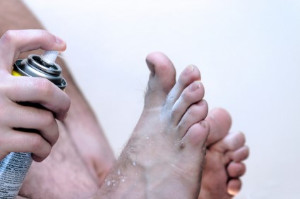
Athlete's foot, or tinea pedis, is a common fungal infection that primarily affects the skin between the toes. It thrives in warm, moist environments, making sweaty feet and tight shoes perfect breeding grounds. Symptoms often include itching, burning, peeling skin, and sometimes blisters or sores. If left untreated, the infection can spread to the toenails or other parts of the body. While antifungal creams and powders might help mild cases, severe or persistent symptoms may require medical intervention. If you experience intense pain, swelling, or signs of a secondary bacterial infection, such as redness or discharge, it is important to see a podiatrist. This type of doctor may prescribe stronger antifungal medications or investigate underlying conditions that could be contributing to the problem. If symptoms persist, it is suggested you schedule an appointment with a podiatrist for expert care and tailored treatment options.
Athlete’s Foot
Athlete’s foot is often an uncomfortable condition to experience. Thankfully, podiatrists specialize in treating athlete’s foot and offer the best treatment options. If you have any questions about athlete’s foot, consult with one of our podiatrists from Foothill Podiatry Clinic. Our doctors will assess your condition and provide you with quality treatment.
What Is Athlete’s Foot?
Tinea pedis, more commonly known as athlete’s foot, is a non-serious and common fungal infection of the foot. Athlete’s foot is contagious and can be contracted by touching someone who has it or infected surfaces. The most common places contaminated by it are public showers, locker rooms, and swimming pools. Once contracted, it grows on feet that are left inside moist, dark, and warm shoes and socks.
Prevention
The most effective ways to prevent athlete’s foot include:
Symptoms
Athlete’s foot initially occurs as a rash between the toes. However, if left undiagnosed, it can spread to the sides and bottom of the feet, toenails, and if touched by hand, the hands themselves. Symptoms include:
Diagnosis and Treatment
Diagnosis is quick and easy. Skin samples will be taken and either viewed under a microscope or sent to a lab for testing. Sometimes, a podiatrist can diagnose it based on simply looking at it. Once confirmed, treatment options include oral and topical antifungal medications.
If you have any questions, please feel free to contact our office located in Grass Valley, CA . We offer the newest diagnostic and treatment technologies for all your foot care needs.
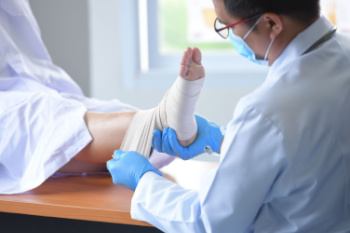
A broken ankle, or ankle fracture, occurs when one or more of the bones in the ankle joint break. The ankle is made up of three main bones, the tibia or shinbone, the fibula which is the outer bone of the lower leg, and the talus or foot bone. These fractures can happen due to various causes, including falls, sports injuries, or accidents. Symptoms of a broken ankle often include severe pain, swelling, bruising, and difficulty bearing weight on the affected foot. In some cases, you may even hear a popping or snapping sound at the time of injury. Prompt diagnosis and treatment are important to ensure proper healing and to avoid long-term complications. If you suspect you have a broken ankle, it is important to seek medical attention. It is suggested you make an emergency appointment with a podiatrist to get the care you need to get back on your feet.
Broken ankles need immediate treatment. If you are seeking treatment, contact one of our podiatrists from Foothill Podiatry Clinic. Our doctors can provide the care you need to keep you pain-free and on your feet.
Broken Ankles
A broken ankle is experienced when a person fractures their tibia or fibula in the lower leg and ankle area. Both of these bones are attached at the bottom of the leg and combine to form what we know to be our ankle.
When a physician is referring to a break of the ankle, he or she is usually referring to a break in the area where the tibia and fibula are joined to create our ankle joint. Ankles are more prone to fractures because the ankle is an area that suffers a lot of pressure and stress. There are some obvious signs when a person experiences a fractured ankle, and the following symptoms may be present.
Symptoms of a Fractured Ankle
If you suspect an ankle fracture, it is recommended to seek treatment as soon as possible. The sooner you have your podiatrist diagnose the fracture, the quicker you’ll be on the way towards recovery.
If you have any questions, please feel free to contact our office located in Grass Valley, CA . We offer the newest diagnostic and treatment technologies for all your foot care needs.
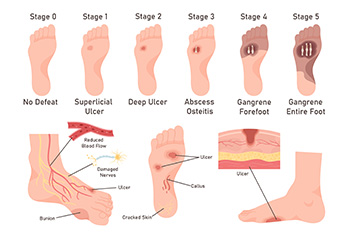
Neuropathic ulcers are serious foot wounds often associated with conditions like diabetes. They develop as the result of nerve damage, which can reduce sensation and lead to injuries going unnoticed. Common symptoms of foot ulcers include localized redness, swelling, and a foul odor. The ulcer itself may appear as an open sore, often located on pressure points like the heel or ball of the foot. Treatment is important to prevent complications, such as infections or amputations. Initial steps include keeping the ulcer clean and dry, often using saline solutions for cleansing. Debridement, or removal of dead tissue, may be necessary to promote healing. Offloading the affected area by using specialized footwear or orthotic devices helps alleviate pressure and facilitates recovery. If you suspect you have a neuropathic foot ulcer, it is suggested you schedule an appointment with a podiatrist. This specialist can provide expert care tailored to your needs and help ensure a successful recovery.
Wound care is an important part in dealing with diabetes. If you have diabetes and a foot wound or would like more information about wound care for diabetics, consult with one of our podiatrists from Foothill Podiatry Clinic. Our doctors will assess your condition and provide you with quality foot and ankle treatment.
What Is Wound Care?
Wound care is the practice of taking proper care of a wound. This can range from the smallest to the largest of wounds. While everyone can benefit from proper wound care, it is much more important for diabetics. Diabetics often suffer from poor blood circulation which causes wounds to heal much slower than they would in a non-diabetic.
What Is the Importance of Wound Care?
While it may not seem apparent with small ulcers on the foot, for diabetics, any size ulcer can become infected. Diabetics often also suffer from neuropathy, or nerve loss. This means they might not even feel when they have an ulcer on their foot. If the wound becomes severely infected, amputation may be necessary. Therefore, it is of the upmost importance to properly care for any and all foot wounds.
How to Care for Wounds
The best way to care for foot wounds is to prevent them. For diabetics, this means daily inspections of the feet for any signs of abnormalities or ulcers. It is also recommended to see a podiatrist several times a year for a foot inspection. If you do have an ulcer, run the wound under water to clear dirt from the wound; then apply antibiotic ointment to the wound and cover with a bandage. Bandages should be changed daily and keeping pressure off the wound is smart. It is advised to see a podiatrist, who can keep an eye on it.
If you have any questions, please feel free to contact our office located in Grass Valley, CA . We offer the newest diagnostic and treatment technologies for all your foot care needs.
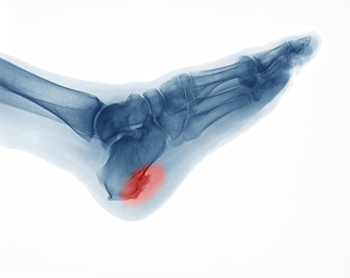
Bone spurs, or osteophytes, are bony growths that can develop on the heel due to excessive stress, injury, or conditions like plantar fasciitis. These spurs typically form where tendons and ligaments attach to the bone, causing localized pain and discomfort. Symptoms of heel bone spurs include sharp or aching pain, especially with the first steps in the morning or after prolonged periods of rest. Swelling and inflammation surrounding the heel may also be present. Relief often involves a combination of approaches to alleviate pain and reduce inflammation. This can include wearing supportive footwear, using custom orthotics, and resting the affected area. Stretching exercises may also be beneficial. In more severe cases, corticosteroid injections or surgery might be necessary. To address heel pain and explore effective treatments, it is suggested you schedule an appointment with a podiatrist who can provide tailored care for your condition.
Heel spurs can be incredibly painful and sometimes may make you unable to participate in physical activities. To get medical care for your heel spurs, contact one of our podiatrists from Foothill Podiatry Clinic. Our doctors will do everything possible to treat your condition.
Heels Spurs
Heel spurs are formed by calcium deposits on the back of the foot where the heel is. This can also be caused by small fragments of bone breaking off one section of the foot, attaching onto the back of the foot. Heel spurs can also be bone growth on the back of the foot and may grow in the direction of the arch of the foot.
Older individuals usually suffer from heel spurs and pain sometimes intensifies with age. One of the main condition's spurs are related to is plantar fasciitis.
Pain
The pain associated with spurs is often because of weight placed on the feet. When someone is walking, their entire weight is concentrated on the feet. Bone spurs then have the tendency to affect other bones and tissues around the foot. As the pain continues, the feet will become tender and sensitive over time.
Treatments
There are many ways to treat heel spurs. If one is suffering from heel spurs in conjunction with pain, there are several methods for healing. Medication, surgery, and herbal care are some options.
If you have any questions feel free to contact our office located in Grass Valley, CA . We offer the latest in diagnostic and treatment technology to meet your needs.
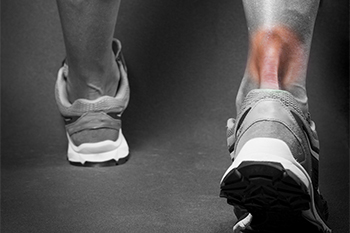
Achilles tendinopathy is a an injury that affects the Achilles tendon, which connects the calf muscles to the heel bone. This ailment typically arises from overuse or repetitive stress on the tendon, often seen in athletes who engage in activities like running or jumping. It can also develop from sudden increases in physical activity or improper footwear. Symptoms usually include pain and stiffness along the back of the heel, which may worsen with activity and improve with rest. The pain is often felt in the lower part of the calf or directly above the heel. Swelling and tenderness in the affected area are also common. If you have endured an Achilles tendon injury, it is suggested that you visit a podiatrist for a proper diagnosis to determine the type of injury and offer appropriate treatment solutions.
Achilles tendon injuries need immediate attention to avoid future complications. If you have any concerns, contact one of our podiatrists of Foothill Podiatry Clinic. Our doctors can provide the care you need to keep you pain-free and on your feet.
What Is the Achilles Tendon?
The Achilles tendon is a tendon that connects the lower leg muscles and calf to the heel of the foot. It is the strongest tendon in the human body and is essential for making movement possible. Because this tendon is such an integral part of the body, any injuries to it can create immense difficulties and should immediately be presented to a doctor.
What Are the Symptoms of an Achilles Tendon Injury?
There are various types of injuries that can affect the Achilles tendon. The two most common injuries are Achilles tendinitis and ruptures of the tendon.
Achilles Tendinitis Symptoms
Rupture Symptoms
Treatment and Prevention
Achilles tendon injuries are diagnosed by a thorough physical evaluation, which can include an MRI. Treatment involves rest, physical therapy, and in some cases, surgery. However, various preventative measures can be taken to avoid these injuries, such as:
If you have any questions please feel free to contact our office located in Grass Valley, CA . We offer the newest diagnostic tools and technology to treat your foot and ankle needs.